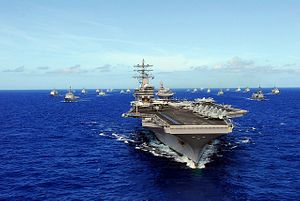Since our new Asia Defense blog will principally deal with the tactics, strategies, doctrines, technology, procurement patterns, and civil-military relations of the militaries of the Asia-Pacific region (including the United States), it may be worthwhile to re-visit Andrew Marshall’s classic “Problems of Estimating Military Power” from August 1966, when Marshall still worked for the RAND corporation, to remind us of an important point when writing on defense issues.
Marshall (I recently wrote another piece on him) argues that the majority of attempts to measure military power are focused on tabulations such as number of men and women under arms, the number of airplanes, ships, and tanks in service, and percentage changes in annual (publicly available) defense budgets. This approach is best exemplified by the annual yearbook on military spending, compiled by the Stockholm International Peace Research Institute (SIPRI). In that regard, the yearbook numbers are useful to some degree but it actually tells us very little about the military strengths of the countries evaluated (the books do contain some analysis).
Looking at the availability of supply bases in a region, transport capacity, and other logistical considerations, along with an assessment of training methods, a force’s esprit de corps, officer to non-commissioned officer to enlisted men ratios, the number of institutes for higher military studies (staff colleges), command and control systems, and military doctrine, we may form a sharper image of a particular military force. However, this singular tunnel vision obviously neglects the dialectical nature of warfare, i.e., the interaction between two opposing forces and how the actions of one side shapes the actions of the other during a prolonged period of military conflict; as well as the relative nature of military competition: The strengths of one military force can only be assessed relative to another military force.
Marshall sums this up in the critique that, “We need to have a way of estimating the probable outcomes of military conflicts given the usual amount of human error, misguided doctrine, and stodgy planning so characteristic of actual warfare.” However, what makes Marshall’s short paper truly unique is his analysis of bureaucratic politics, and how one has to re-examine the rational actor model and what I would call the monolithic grand strategy approach when studying military power. Commenting on analyzing Soviet military power Marshall elaborates:
“The usual method of explanation (and a tendency in making forecasts) is to assume that there is not only a monolithic, unified decisionmaking process which leads to a coherent rational design for Soviet military postures, but that the execution of top level decisions is carried out with little or no friction or resistance from the elements several level down in the military bureaucracy (…) We came to believe that not only were such assumptions inappropriate in the sense that they were wrong, but experience has shown to our satisfaction that they did not give (even approximately) likely or valid explanations of the past Soviet force posture, nor could such assumptions give good predictions of future force postures.”
Marshall states that it seems to him, “that most attempts to explain the behavior of governments or large governmental bureaucracies are governed by an intellectualist fallacy.” He continues,
“Most discussion and forms of analysis tend to treat governments, military organizations, etc., as though they were equivalent to individual rational decisionmakers and not the complicated bureaucratic institutions that they in fact are. We know that decisionmaking within large organizations and government bureaucracy is not like that which is predicted on the basis of models of rational optimizing behavior. Thus, even in the more sophisticated, though implicit, attempts to make estimates of military power, many of the assumptions are artificial and likely to be in considerably error.”
This is still uniquely relevant for today, especially when discussing military power with the public. What I find exceptionally interesting is that we often apply this sort of bureaucratic political analysis to analyzing actions of the United States and its allies, yet often fail to acknowledge the possibility when commenting on military developments in countries such as Iran, Russian, or China. For example, carefully watch how news headlines are drafted – partially done for stylistic reasons – about “China’s naval ambitions,” “Iran’s aggressive regional strategy,” or “Russia’s (or Putin’s) dream of regional hegemony,” rather than “The naval ambitions of the People’s Liberation Army-Navy,” “The Iranian Revolutionary Guard’s aggressive regional strategy,” and “The Russian military’s dream of regional hegemony.” What the latter titles implicitly invoke is the presence of other forces or factions in the country, which might counter this ambitions and goals (even if a unified national security strategy exists).
While sinister ulterior motives, such as inflating the national security threat emerging from those countries, may be too farfetched to explain this continuous use of generalizations, what we can say for sure is that monolithic analyses do not provide the larger public with a nuanced picture. We often genuinely do not know what is really happening internally within the governments and bureaucracies of other nations.
The important thing is not to convince military analysts of the validity of Marshall’s argument – bureaucratic politics has become widely accepted gospel – but to educate politicians and the public on how to properly digest and evaluate debates on national defense, and international conflict, and most importantly, how to ask the right questions. Andrew Marshall’s monograph provides a good starting point.

































